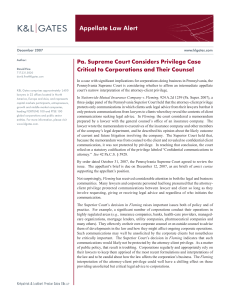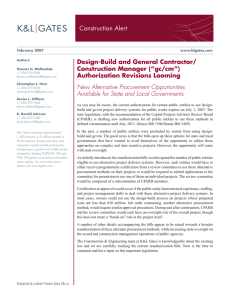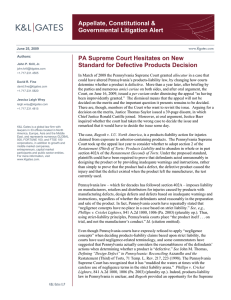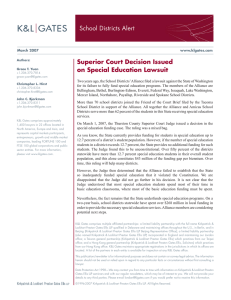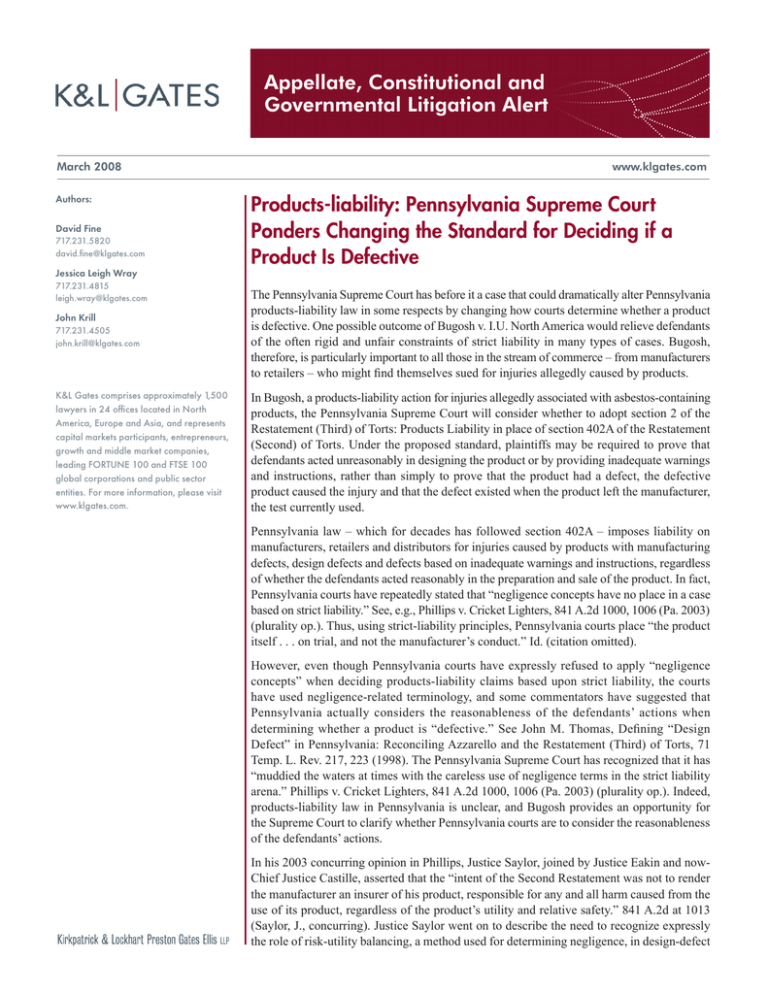
Appellate, Constitutional and
Governmental Litigation Alert
March 2008
Authors:
David Fine
717.231.5820
david.fine@klgates.com
Jessica Leigh Wray
717.231.4815
leigh.wray@klgates.com
www.klgates.com
Products-liability: Pennsylvania Supreme Court
Ponders Changing the Standard for Deciding if a
Product Is Defective
717.231.4505
john.krill@klgates.com
The Pennsylvania Supreme Court has before it a case that could dramatically alter Pennsylvania
products-liability law in some respects by changing how courts determine whether a product
is defective. One possible outcome of Bugosh v. I.U. North America would relieve defendants
of the often rigid and unfair constraints of strict liability in many types of cases. Bugosh,
therefore, is particularly important to all those in the stream of commerce – from manufacturers
to retailers – who might find themselves sued for injuries allegedly caused by products.
K&L Gates comprises approximately 1,500
lawyers in 24 offices located in North
America, Europe and Asia, and represents
capital markets participants, entrepreneurs,
growth and middle market companies,
leading FORTUNE 100 and FTSE 100
global corporations and public sector
entities. For more information, please visit
www.klgates.com.
In Bugosh, a products-liability action for injuries allegedly associated with asbestos-containing
products, the Pennsylvania Supreme Court will consider whether to adopt section 2 of the
Restatement (Third) of Torts: Products Liability in place of section 402A of the Restatement
(Second) of Torts. Under the proposed standard, plaintiffs may be required to prove that
defendants acted unreasonably in designing the product or by providing inadequate warnings
and instructions, rather than simply to prove that the product had a defect, the defective
product caused the injury and that the defect existed when the product left the manufacturer,
the test currently used.
John Krill
Pennsylvania law – which for decades has followed section 402A – imposes liability on
manufacturers, retailers and distributors for injuries caused by products with manufacturing
defects, design defects and defects based on inadequate warnings and instructions, regardless
of whether the defendants acted reasonably in the preparation and sale of the product. In fact,
Pennsylvania courts have repeatedly stated that “negligence concepts have no place in a case
based on strict liability.” See, e.g., Phillips v. Cricket Lighters, 841 A.2d 1000, 1006 (Pa. 2003)
(plurality op.). Thus, using strict-liability principles, Pennsylvania courts place “the product
itself . . . on trial, and not the manufacturer’s conduct.” Id. (citation omitted).
However, even though Pennsylvania courts have expressly refused to apply “negligence
concepts” when deciding products-liability claims based upon strict liability, the courts
have used negligence-related terminology, and some commentators have suggested that
Pennsylvania actually considers the reasonableness of the defendants’ actions when
determining whether a product is “defective.” See John M. Thomas, Defining “Design
Defect” in Pennsylvania: Reconciling Azzarello and the Restatement (Third) of Torts, 71
Temp. L. Rev. 217, 223 (1998). The Pennsylvania Supreme Court has recognized that it has
“muddied the waters at times with the careless use of negligence terms in the strict liability
arena.” Phillips v. Cricket Lighters, 841 A.2d 1000, 1006 (Pa. 2003) (plurality op.). Indeed,
products-liability law in Pennsylvania is unclear, and Bugosh provides an opportunity for
the Supreme Court to clarify whether Pennsylvania courts are to consider the reasonableness
of the defendants’ actions.
In his 2003 concurring opinion in Phillips, Justice Saylor, joined by Justice Eakin and nowChief Justice Castille, asserted that the “intent of the Second Restatement was not to render
the manufacturer an insurer of his product, responsible for any and all harm caused from the
use of its product, regardless of the product’s utility and relative safety.” 841 A.2d at 1013
(Saylor, J., concurring). Justice Saylor went on to describe the need to recognize expressly
the role of risk-utility balancing, a method used for determining negligence, in design-defect
Appellate, Constitutional and Governmental Litigation Alert
litigation and to suggest that the court look to the
Restatement (Third) for an alternative to the current
law. Id. at 1015-16, 1018-19. The fact that the Supreme
Court has agreed to hear Bugosh may signal that,
with a significantly changed composition, the court
is considering adopting section 2 now (notably, nowChief Justice Castille and Justices Saylor and Eakin
remain on the court).
The following question remains: what are the
implications of adopting section 2 of the Restatement
(Third)? Section 2 provides standards for determining
whether a product was “defective” and divides product
defects into three categories—manufacturing defects,
design defects and defects based on inadequate
instructions or warnings (although Pennsylvania
jurisprudence already tends to separate defects
accordingly). This determination is significant because,
once a product is determined to be “defective,” those
who sell or distribute defective products may be
subject to liability for injuries caused by the defect.
See Restatement (Third) of Torts: Products Liability
§ 1 (1998).
Manufacturing defects occur “when the product departs
from its intended design even though all possible care
was exercised in the preparation and marketing of
the product.” Id. § 2(a). Therefore under section 2,
courts might continue to apply strict liability to claims
concerning products with manufacturing defects, and
manufacturers, retailers and distributors might still be
responsible for injuries regardless of fault.
However, for allegations of design or warning defects,
products will be deemed defective if the risks of harm
were “foreseeable” and the risks of harm could have
been reduced by a “reasonable alternative design” or
“reasonable instructions or warnings.” Id. § 2(a), (b).
As one commentator wrote, “Thus, in both design
and warning cases, liability is defined functionally
in terms of whether the manufacturer reasonably
could have provided a safer product.” David Owen,
Products Liability Law Restated, 49 S.C. L. Rev. 273,
286 (1998).
Accordingly, were the Supreme Court to adopt
section 2, Pennsylvania law would no longer follow
the same strict-liability regime for products-liability
claims for design defects and inadequate warnings and
instructions. Plaintiffs would be required to show the
defendants were at fault for the defect by establishing
the unreasonableness of the defendants’ actions. While
such an approach would not benefit defendants in all
cases, it would bring helpful balance to many cases.
Bugosh offers an opportunity to remove confusion and
to ameliorate the harsh and sometimes unreasonable
results of Pennsylvania’s often rigid products-liability
jurisprudence. Manufacturers, retailers and distributors
have an opportunity still to weigh in with amicus briefs
in Bugosh. Since the court is almost certain to receive
considerable pressure from those who support the
current regime, it may be particularly important for
those who are or who may be defendants in productsliability cases to assert themselves in Bugosh. Under
the current schedule, amicus briefs are due in midApril. K&L Gates’s Appellate, Constitutional and
Governmental Litigation Practice Group will be
following this case closely.
K&L Gates comprises multiple affiliated partnerships: a limited liability partnership with the full name Kirkpatrick & Lockhart Preston Gates Ellis LLP
qualified in Delaware and maintaining offices throughout the U.S., in Berlin, and in Beijing (Kirkpatrick & Lockhart Preston Gates Ellis LLP Beijing
Representative Office); a limited liability partnership (also named Kirkpatrick & Lockhart Preston Gates Ellis LLP) incorporated in England and
maintaining our London office; a Taiwan general partnership (Kirkpatrick & Lockhart Preston Gates Ellis - Taiwan Commercial Law Offices) which
practices from our Taipei office; and a Hong Kong general partnership (Kirkpatrick & Lockhart Preston Gates Ellis, Solicitors) which practices from
our Hong Kong office. K&L Gates maintains appropriate registrations in the jurisdictions in which its offices are located. A list of the partners in
each entity is available for inspection at any K&L Gates office.
This publication/newsletter is for informational purposes and does not contain or convey legal advice. The information herein should not be used
or relied upon in regard to any particular facts or circumstances without first consulting a lawyer.
Data Protection Act 1998—We may contact you from time to time with information on Kirkpatrick & Lockhart Preston Gates Ellis LLP seminars and
with our regular newsletters, which may be of interest to you. We will not provide your details to any third parties. Please e-mail london@klgates.
com if you would prefer not to receive this information.
©1996-2008 Kirkpatrick & Lockhart Preston Gates Ellis LLP. All Rights Reserved.
March 2008 | 2


